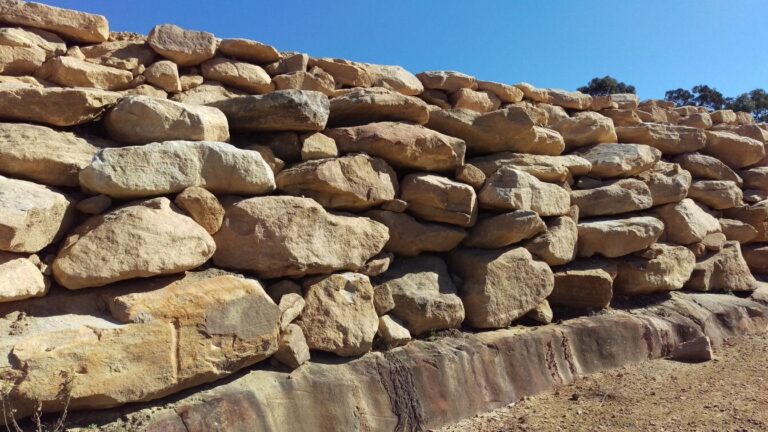Sandstone Boulder Rock Retaining | A boulder rock retaining wall can transform any outdoor space, providing a natural and rustic aesthetic while offering functionality and strength. Whether you’re looking to add visual interest, prevent soil erosion, or also create a tiered garden. Additionally, sandstone boulder Rock Retaining – rock walls are an excellent choice for both residential and commercial landscaping projects.
Why Choose a Sandstone Boulder Rock Retaining Wall?
1. Natural Beauty
Sandstone Boulder rock retaining wall dimensions come in a variety of shapes, sizes, and colours. Therefore, making them perfect for blending into the natural environment. The rugged and organic appearance of these stones creates a timeless look. Additionally, that complements both modern and traditional sandstone landscapes. Whether you’re aiming for a natural woodland feel or a more structured garden design, boulder rocks add a unique charm.
2. Durability and Strength
One of the biggest advantages of a sandstone boulder rock retaining wall is their durability. These massive stones are incredibly strong and can hold back large amounts of soil without shifting or cracking over time. Boulder walls are built to last. Therefore, withstanding the elements and maintaining their integrity through years of weather exposure.
3. Erosion Control
Retaining walls made from boulder rocks are an effective solution for controlling soil erosion. By stabilizing sloped areas, they help prevent soil from washing away during heavy rains. This makes boulder retaining walls particularly useful in hilly or uneven terrains, where erosion is a common problem.
4. Environmentally Friendly
Using natural boulders is a sustainable choice. Unlike manufactured materials, boulder rocks are found in nature and do not require energy-intensive production processes. This minimizes the environmental impact of your project. Additionally, their natural properties mean that they blend seamlessly into the landscape, contributing to the ecological balance.
Design Ideas for Boulder Rock Retaining Walls
1. Tiered Garden Beds
If you have a sloped yard, a tiered boulder rock retaining wall can help create multiple levels for planting. Each tier can serve as a separate garden bed, perfect for growing flowers, shrubs, or even vegetables. This not only maximizes your planting space but also adds depth and visual interest to your landscape.
2. Integrating Seating Areas
Large boulders can double as seating areas in your outdoor space. By strategically placing flat-topped boulders within the wall, you can create natural benches. This is a great option for fire pits, patios, or garden gathering spaces, where functionality meets aesthetics.
3. Water Features
Consider incorporating a waterfall or stream into your boulder rock retaining wall design. The natural shapes of the rocks allow water to cascade beautifully, adding a soothing, tranquil element to your yard. A water feature can elevate the entire look of your landscape and create a serene atmosphere.
4. Pathways and Steps
Boulder rocks can also be used to create natural-looking steps or pathways. This is especially useful in sloped areas where retaining walls are required. By integrating stone steps into the wall, you can create a seamless transition between different levels of your landscape, adding both functionality and style.
The Process of Building a Boulder Rock Retaining Wall
Building a boulder rock retaining wall requires careful planning and execution. Here’s an overview of the key steps involved:
1. Site Preparation
First, assess the area where the wall will be built. Proper drainage and soil stability are critical for a long-lasting retaining wall. Clear the area of any debris, mark the boundary lines, and prepare the foundation.
2. Choosing the Right Boulders
Selecting the right size and type of boulders is essential. Larger boulders should be placed at the base of the wall to provide stability, with smaller rocks stacked on top. The rocks should fit together naturally without large gaps, ensuring the wall is secure.
3. Layering and Backfilling
As the boulders are stacked, the area behind the wall must be backfilled with gravel or crushed stone to allow proper drainage and prevent pressure buildup. Each layer of the wall should be set back slightly from the one below to create a sloping effect, ensuring stability.
4. Finishing Touches
Once the boulders are in place and backfilling is complete, add soil and plants to the top layer. You can plant ground cover or native plants that will grow between the crevices, adding a lush, natural feel to your wall.
Conclusion
A boulder rock retaining wall not only enhances the beauty of your outdoor space but also provides essential functionality such as erosion control and terracing. Whether you want to add depth to your garden or create a strong, lasting structure for your property, boulder rocks offer a durable and visually stunning solution. Their raw beauty, coupled with practical benefits, makes them an excellent choice for any landscape design.
Consider adding a boulder rock retaining wall to your next landscaping project to create an outdoor space that is both timeless and built to last.




